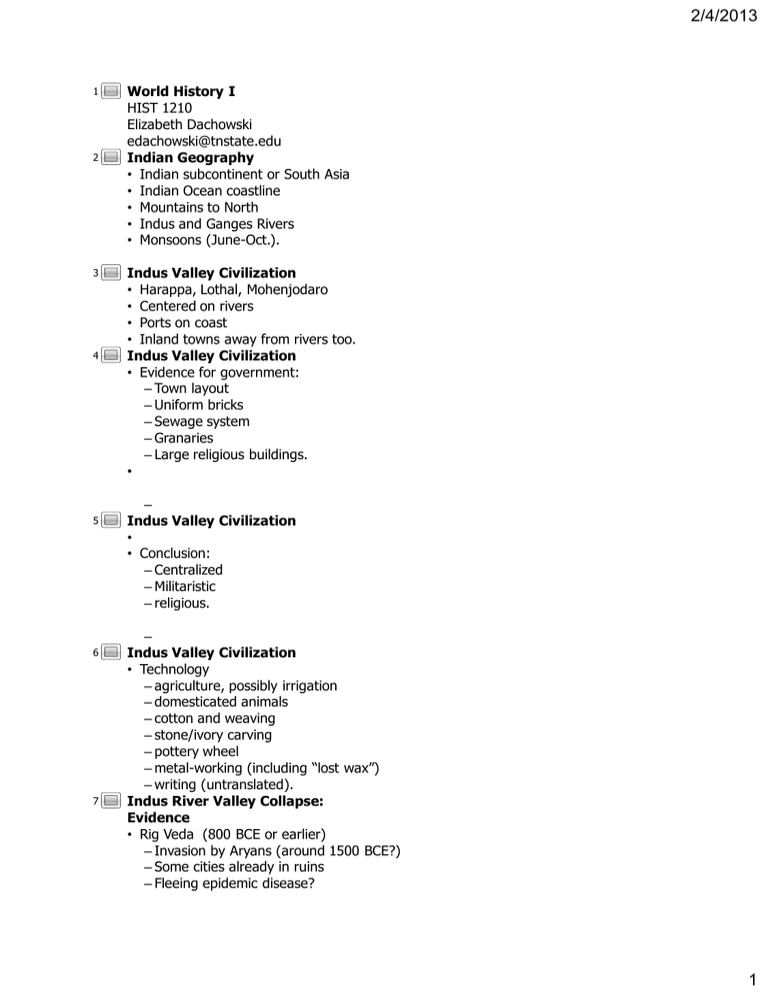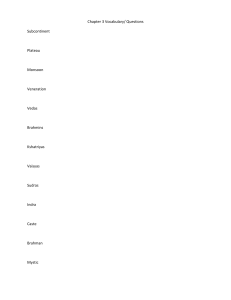2/4/2013
advertisement

2/4/2013 1 2 3 4 5 6 7 World History I HIST 1210 Elizabeth Dachowski edachowski@tnstate.edu Indian Geography • Indian subcontinent or South Asia • Indian Ocean coastline • Mountains to North • Indus and Ganges Rivers • Monsoons (June-Oct.). Indus Valley Civilization • Harappa, Lothal, Mohenjodaro • Centered on rivers • Ports on coast • Inland towns away from rivers too. Indus Valley Civilization • Evidence for government: – Town layout – Uniform bricks – Sewage system – Granaries – Large religious buildings. • – Indus Valley Civilization • • Conclusion: – Centralized – Militaristic – religious. – Indus Valley Civilization • Technology – agriculture, possibly irrigation – domesticated animals – cotton and weaving – stone/ivory carving – pottery wheel – metal-working (including “lost wax”) – writing (untranslated). Indus River Valley Collapse: Evidence • Rig Veda (800 BCE or earlier) – Invasion by Aryans (around 1500 BCE?) – Some cities already in ruins – Fleeing epidemic disease? 8 1 2/4/2013 8 9 10 11 12 13 – Indus River Valley Collapse: Evidence • Archaeology: – Buildings in ruins (no evidence of violent deaths) – Drier climate, disappearance of Saraswati River – Continued habitation of ruins. • – Indus River Valley Collapse • Theories of collapse – Invasions – Ecological disaster – Break-down of central government. • – Ganges River Valley and Aryans • Aryan invasions in 1500s BCE • New centers of civilization – Ganges River Valley – Sri Lanka. • Working through the Rig Veda’s “Hymn to Creation” • Divine and legendary figures: – “Thousand-headed Purusha” • =“first man” and “universal self” (Leeming, David. "Purusha." In The Oxford Companion to World Mythology. : Oxford University Press, 2005. Oxford Reference Books Online Premium. ) – “From him was Viraj born, from Viraj evolved Purusha” • =“the first offspring of Brahmā” (Johnson, W. J. "Virāj." In A Dictionary of Hinduism. Oxford University Press, 2009. Oxford Reference Books Online Premium.) – “from the mouth Indra and Agni” • Indra =“king of the gods” and Agni=“fire god” Leeming, David. "Indra." In A Dictionary of Asian Mythology. : Oxford University Press, 2001 and "Agni." In World Encyclopedia. : Philip's. Oxford Reference Books Online Premium. – – Working through the Rig Veda’s “Hymn to Creation” • Religious rituals – “then the spring was its clarified butter, the summer the sacrificial fuel, and the autumn the oblation” – “sprinkled with sacred water” – “verses and sacred chants” – – – – Working through the Rig Veda’s “Hymn to Creation” 2 2/4/2013 Working through the Rig Veda’s “Hymn to Creation” • What were the important elements in creation – “verses and the sacred chants” – horses, cows, goats, sheep – Brahman, rajanya [=kshatriya], vaishyas, shudra – the moon, the sun – Indra and Agni – the wind – atmosphere, heaven, earth. – – – – Working through the Rig Veda’s “Hymn to Creation” • Nature of Purusha – “pervaded the earth on all sides, still extends ten fingers beyond it” – “whatever has been and whatever is going to be” – “lord of immortality and also of what grows on account of food” – “All creatures constitute but one quarter of him” – “the sacrificial victim” – – – – Writing (5 minutes) • What can you say about Aryan (early Indian) religion and culture based on “The Hymn to Creation” in the Rig Veda? Ganges River Valley and Aryans • Evidence – Sanskrit (Indo-European language family) – Rig Veda, Upanishads, other literature – Archaeology and artwork. • Vedic Religion • Many gods • Varnas: 4 classes • Exclusion of untouchables. Vedic Religion • Dharma: duty, maintaining rules of your varna • Karma: righteousness, acquired through dharma • Sansara: rebirth (new varna based on karma) • Moksha: release from cycle of rebirth. • Vedic Religion • Growing formalism (up to 600 BCE): – prayers – sacrifices – ceremonies – strict adherence to rules of your varna. • Aryan Society: Four Varnas 13 14 15 16 17 18 19 20 2 3 2/4/2013 20 2 21 2 22 2 23 2 24 Aryan Society: Four Varnas • All varnas: – dietary restrictions – marriage restrictions – occupational restrictions. – – – – Aryan Society: Four Varnas • Brahmans: – priests – reading sacred texts – remaining separate from other varnas – performing rituals. – Aryan Society: Four Varnas • Kshatriya – warriors, rulers • Vaishya – merchants • Shudra – commoners: tillers, herders, laborers, servants. – Aryan Society: Four Varnas • Castes (jati) – subdivisions of varnas – more fluid than varnas – Later Developments in Hinduism (after about 600 BCE) • Varied forms of religious expression – Worship of many gods – Rituals (daily or seasonal) – Personal meditation – Pilgrimage – Smaller offerings – Personal asceticism – Reading of Vedas by warriors – Festivals. 25 26 South Asian Chronology • Harappan period (2500-1600 or 1200 BCE) • Aryan invasions (1700-1000 BCE) • Composition of Rig Veda and other Vedas (1200-700 BCE) • Era of Brahman dominance (700-550 BCE) 4






